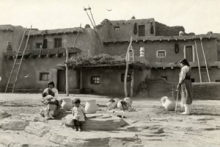Article
The Zuni phrase Halona I'tawana translates as the "Middle Place," and was so named by the Zuni because of its significance as the temporal, spatial, and ceremonial center of Zuni life. The Middle Place is the current site of Zuni Pueblo in western New Mexico, a place that has been continuously inhabited by the Zuni since the water spider K'yhan'asdebi flexed his legs in six directions (the four cardinal directions and up and down). The center of the Middle Place was delineated by the spot where K'yhan'asdebi's heart lay over the land.
Zuni myth recounts that the original Zuni people, or A'shiwi, traveled from the western lands of their gods and the spirits of their ancestors to dicover the Middle Place. After a long and arduous journey of many trials and tribulations, the A'shiwi or Zuni finally discovered the Middle Place. Having learned much along their travels, the Zuni were prepared to settle and build a properous and peaceful life.
"Zuni Pueblo, circa 1920," photograph by unknown. William A. Keleher Collection (000-742-0424). Center for Southwest Research, University of New Mexico.
Manuscripts
References
Bunzel, Ruth Leah
1932 Introduction to Zuni Ceremonialism. 47th Annual report of the Bureau of American
Ethnology. Washington: U.S. Government Printing Office.
Cushing, Frank Hamilton
1896 Outlines of Zuni Creation Myths. Thirteenth Annual Report of the Bureau of Ethnology to the Secretary of the Smithsonian Institution, 1891-92. Washington, D.C.:
Government Printing Office.

